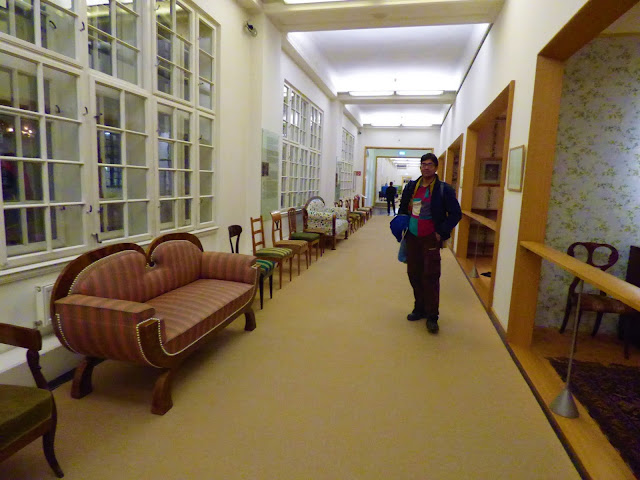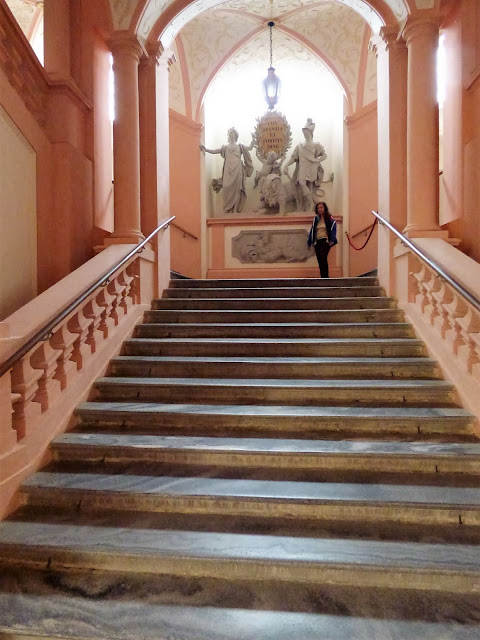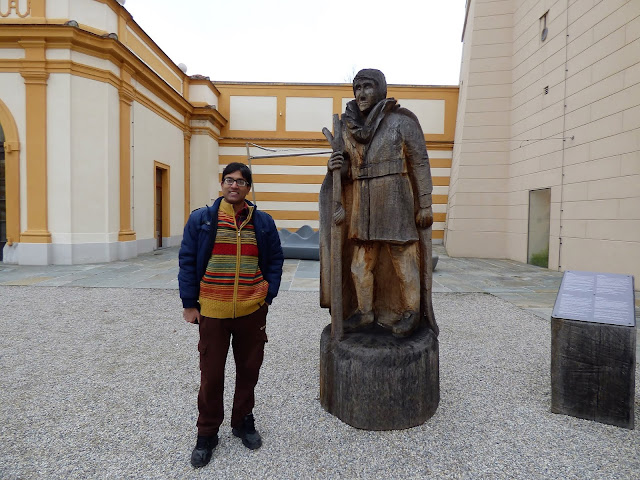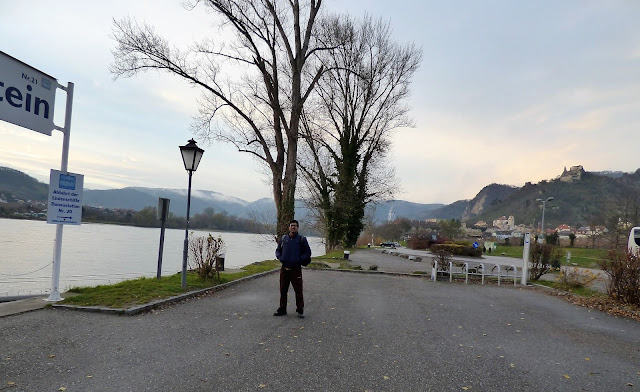DAY 9, 25 NOVEMBER 2017, Saturday:
Before the report on the day trip here are some more pics from the previous day's Imperial furniture museum.
Ivory
Ivory and mother of pearl
Sisi's dairy farm furniture
Royal potties!! Ha, ha
Contemporary designs
The Wachau Valley:
The Wachau valley,
UNESCO World Heritage Site, has a picturesque landscape formed
by the Danube river. It is 40 kilometres (25 mi)
in length . The architectural elegance of its ancient
monasteries (Melk Abbey and Göttweig Abbey), castles and
ruins and the cultivation of vines are the main draw.
The 24-mile stretch of the Wachau between the towns of Melk and Krems is as pretty as river valleys come.
For a fine day trip from Vienna, catch the early train to Melk, tour its glorious abbey, and spend the afternoon meandering down the river to Krems by bike, bus, or boat. From Krems, catch the train back to Vienna.
From May through September, five boats a day make the 1.75-hour trip. (Because of the six-knot flow of the Danube, the same ride back upstream takes three hours.)
Boats were not plying during our visit, so we decided to use the bus; also in the off season, Melk abbey can only be visited through their tours, at 11 and 2. so we decided to make it in time for their 11m tour. Caught the 9.20 train from Vienna hbf to St Poltine, then transferred to Melk.
 |
| Tram to hbf |
Melk is a small town on
the bank of the Danube at the start of the Wachau region at an
elevation of 228 metres (748 ft).
An ancient town linked to
the Romans (as a border post) and also to Babenbergs' times
(as their strong fortress), it forms the western gateway to the
Wachau.
Popularity is on account of the Benedictine
abbey (founded in 1089 AD), located on a 200 feet (61 m)
high cliff. perfect example of a "Baroque synthesis of the arts"
Walked up the Abbey with a little help from locals. Bought the English tour
ticket and had a lovely tour.
Melk Abbey (Benediktinerstift):
The restored Melk Abbey (Benediktinerstift), towers proudly over the Danube Valley. Established as a fortified Benedictine abbey in the 11th century, it was destroyed by fire. What visitors see today is 18th-century Baroque.
Today's Baroque abbey was built between 1702 and 1736. Particularly noteworthy are the abbey church with frescos and the library with countless medieval manuscripts, including a famed collection of musical manuscripts and frescos .
Due to its fame and academic stature, Melk managed to escape dissolution under Emperor Joseph II when many other Austrian abbeys were seized and dissolved between 1780 and 1790. The abbey managed to survive other threats to its existence during the Napoleonic Wars, and also in the period following the Anschluss in 1938, when the school and a large part of the abbey were confiscated by the state.
The school was returned to the abbey after the Second World War and now caters for nearly 900 pupils of both sexes.
The grand restoration
project — financed in part by the sale of the abbey's Gutenberg
Bible to Harvard (which was later donated to Yale University) — was
completed by 1996 to celebrate the 1,000th anniversary of the first
reference to a country named Österreich (Austria).
For 900 years, monks of St. Benedict have lived and worked in Melk's abbey, during the Reformation (1500s), occupation by Napoleon (1800s), and the Nazis (1900s). Today, the institution survives, funded by agriculture and tourists.
High above the grand entry are the Latin words "Glory only in the cross" and a huge copy of the Melk Cross (one of the abbey's greatest treasures — the original is hiding in the treasury, viewable only with special permission).

Inside is the art-lined Imperial corridor, abbey museum, "Marble Hall" (made mostly of stucco) with an impressive 1731 ceiling fresco by Tirolean Paul Troger; library (with another Troger fresco), and the grand finale: the full-on Baroque church with its 200-foot-tall dome and symmetrical towers.

Inside is the art-lined Imperial corridor, abbey museum, "Marble Hall" (made mostly of stucco) with an impressive 1731 ceiling fresco by Tirolean Paul Troger; library (with another Troger fresco), and the grand finale: the full-on Baroque church with its 200-foot-tall dome and symmetrical towers.
We had all the current timetables from the OBB website; knew there are WL1
buses 40 minutes past the hour to Krems. Our tour was over only by
12.25, we could not make the 12.40, so roamed the village a bit before retracing our way back to
the hbf.
The bus for 1.40 was already standing. It would leave a
little later. We had our picnic lunch and then got on the bus ,
bought the tickets from the driver to Dürnstein, which is the town
before Krems.
It was a scenic journey
Dürnstein has
the Kuenringer Castle (now in ruins), where King Richard
the Lion-Heart of England was held captive by
Duke Leopold V from December 1192 to March 1193 .
The ruined castle above
town, where Richard was kept, can be reached by a fairly steep
30-minute hike with great river views.
After the lovely hike we
walked along the banks of the Danube, watched the sun set around
4.30.
then caught the bus to Krems.
There are 2 trains to
Vienna from Krems one at 19min past the hour with transfer at St
Polten, another at 51 min past the hour which is direct and goes to
Franz Josef station in Vienna.
We missed the 5.19 train,
bought tickets for the 5.51 train. Walked to the town center, looked
at shop windows for some 10 min and walked back to the station. Our
train was already standing. We sat in the top deck and reached
Franz Josef station. Took bus no 5 and reached our apartment
It had been a GREAT day... pics do little justice to the mystique beauty we experienced!
Our report continues here:



































































































No comments:
Post a Comment